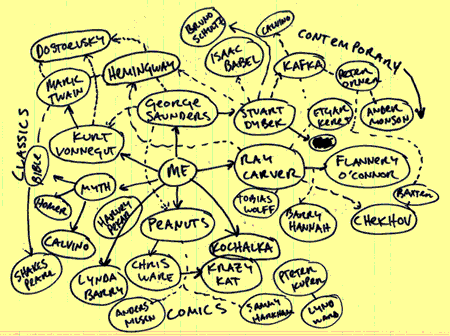I was relieved to hear Gabrielle Bell in the Fall 2005 issue of MOME (take a sneak peek at the new one) confess to Gary Groth, “I’m not so obsessive about comics, actually. I don’t really read that many comics as much as I would like to. I’ve often been really impatient with most comics….The stories, in most cases, even if they’re good, they’re still not as good as most books, most novels are. So it’s frustrating to read a comic when I could be reading some great literature.”
John Hodgman quoted her interview in his “Comics Chronicle” piece in the recent NYTimes Book Review, and added his own two cents: “I have not been as brave as she to admit even to myself (never mind to Gary Groth), that many of the alternative fine-art comics that cross my desk these days are kind of boring. I’ve been quiet on this point in part because I do believe comics are literature, and do not wish to undermine the cause…”
So much of the past year has been about me slowly coming around to the fact that comics — and the graphic novel form in particular — is what I’m meant to do, and that my frustration with the form (the thin plots, boring characters, mediocre artwork) is really just a big blinking neon sign pointing to the void which I hope that my own work will fill. As Dylan Horrocks points out in his Scott McCloud essay, “The problem with comics is that people associate them not with what they could be, but with what they have been.”
Yesterday I read some great workshop advice from Kelly Link (via). Essentially, the advice was: don’t play it safe. There are way too many people out there churning out competant, respectable work. The only way to rise above it all is to push yourself to your absolute limits. Take big risks.
For me, making comics is turning my back on playing it safe. It’s about pushing myself to that terrifying yet exhilarating place where I have no idea what I’m doing, but it’s so much fun, and I’m right on the edge of my skills.
My old friend Jeremy is doing it right now with his music. Two years ago he was writing competant, respectable pop songs. Then one day he sat down and realized that it all bored the hell out of him. He started from scratch, totally re-invented his sound. Now he’s on the verge of having his first album out, and it’s going to be really, really good — but only because he pushed himself. (Check out his new single, “I Promise,” over at his website or MySpace.)
I’m about to start out on my first graphic novel. I have no idea how I’m going to do it. It feels dangerous. It feels scary.
And it feels great.









